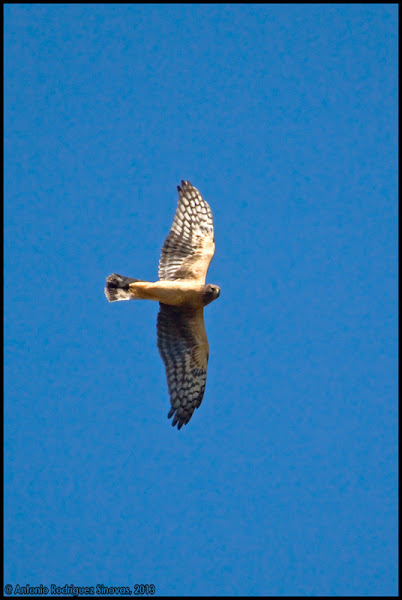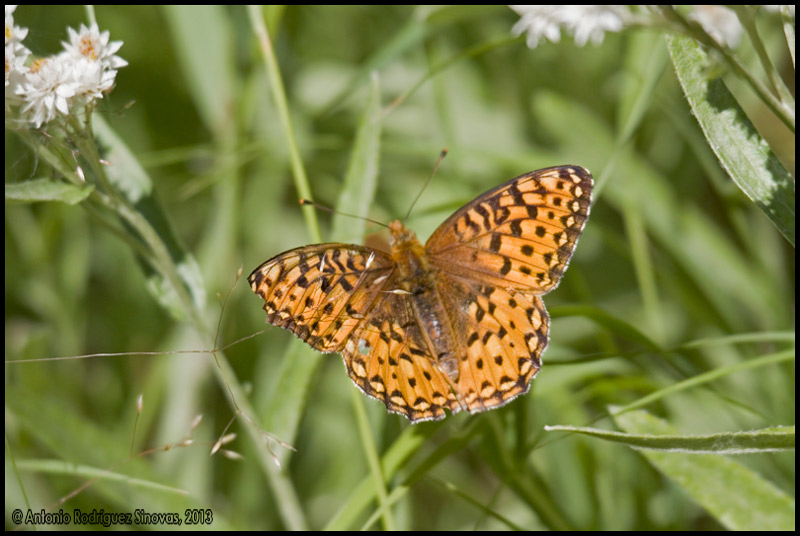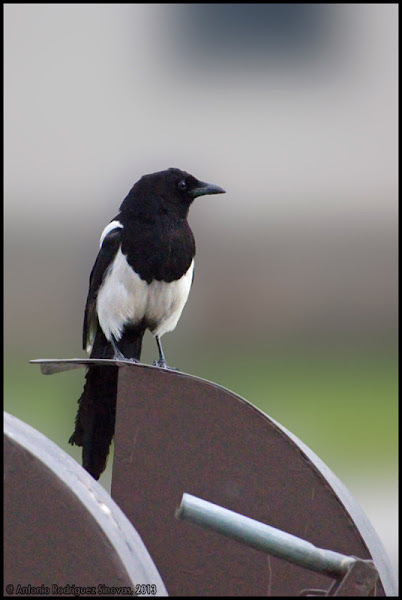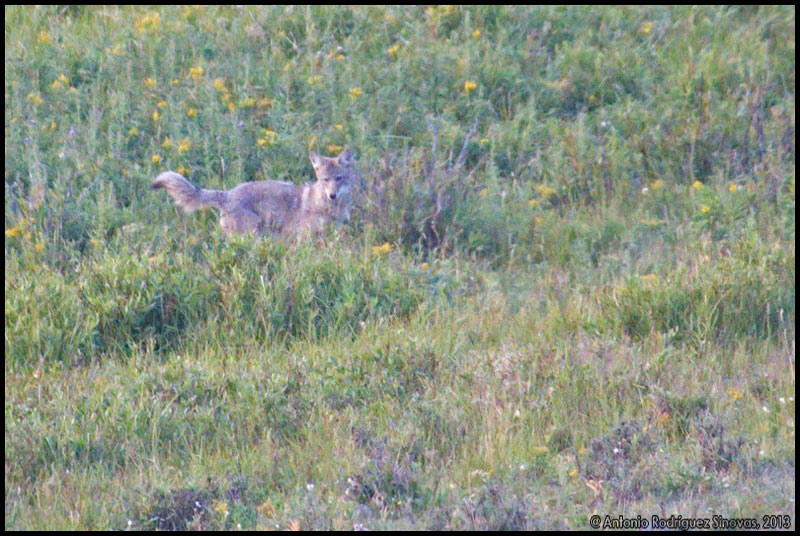Yellowstone es la tierra de las maravillas. La mayoría de los géiseres del mundo se encuentran aquí, incluyendo el famoso Old Faithful. Ellos fueron la principal razón por la que se creó, en 1872, el primer parque nacional de América y del mundo. Esta tierra montañosa salvaje, donde viven osos pardos, lobos, y rebaños de bisontes y ciervos, es el centro de uno de los últimos ecosistemas que permanecen prácticamente intactos en la zona templada de la Tierra. El parque es enorme, por lo que se necesita cierto tiempo para poder visitarlo. Estuvimos 2 noches en la parte sur, alojados en Grant Village, y otras 4 en la norte, en Mammoth Hot Springs.
It's wonderland. Most of the world's geysers, including Old Faithful, are preserved here. They are the main reason the park was established in 1872 as world's first national park. A mountain wildland, home to grizzly bears, wolves, and herds of bison and elk, is the core of one of the last, nearly intact, natural ecosystems in the Earth’s temperate zone. This park is huge. For these reason we spent 2 nights in the south, in Grant Village, and 4 nights in the north, in Mammoth Hot Springs.
Para información sobre rutas, mapas, alojamientos, etc., recomiendo visitar la página web del Yellowstone National Park. Así mismo, puede encontrarse información adicional en este enlace.
To know more about the park (maps, trails, where to sleep, etc) I recommend to visit the Yellowstone National Park web page. Additional information can be found in this link.
If you want information of other places visited during this summer trip, click on the links below:
Bear River Migratory Bird Refuge
Grand Teton National Park
Yellowstone National Park
Glacier National Park
If you want to see my previou trip (2009) to Grand Teton, Yellowstone, Bryce Canyon and Zion National Parks, click on the links below:
Grand Teton-Yellowstone-Bryce-Zion (2009)
En rojo los puntos visitados / In red are the places visited.
1. Lewis River, West Thumb Geyser Basin y Yellowstone Lake.
Desde Grand Teton National Park se accede al parque de Yellowstone recorriendo el valle del Lewis River. Merece la pena hacer alguna parada junto al río, para ver la fauna asociada. Pasamos más rato, eso sí, en West Thumb Geyser Basin, cerca de Grant Village. Es una zona de fuentes termales de diferentes colores y géiseres dormidos en la orilla del lago Yellowstone. Merece la pena también visitar el lago, en el mismo Grant Village, ya que es posible disfrutar de los porrones islándicos, las gaviotas californianas y serretas grandes.
From Grand Teton National Park you reach Yellowstone through the Lewis River valley. It is interesting to stop for a while to see the associated wildlife. We also visited the West Thumb Geyser Basin, near Grant Village. This is a geyser basin of colorful hot springs and dormant lakeshore geysers situated on the scenic shores of Yellowstone Lake. A visit to the lake in Grant Village is also of interest, as you can see Barrow's goldeneyes, california gulls and other species.
Ruta por West Thumb Geyser Basin, Yellowstone Lake y Lewis River (Yellowstone National Park, Wyoming)
2. DeLacy Creek Trail y Shoshone Lake.
Recorriendo el límite del bosque y praderas abiertas se llega a la orilla del mayor lago interior del parque de Yellowstone, el lago Shoshone (a parte, por supuesto, del propio Yellowstone Lake). Es posible localizar grullas canadienses en las praderas (vimos varias), alce cerca de la orilla del lago, y aves acuáticas cerca del lago.
Hike along a forest’s edge and through open meadows to arrive to the shores of Yellowstone’s largest backcountry lake, the Shoshone Lake. It is possible to look for sandhill cranes in meadows, moose near shore, and water birds on and near the lake.
Ruta a Shoshone Lake por el DeLacy Creek Trail (Yellowstone National Park, Wyoming)
3. Old Faithful Area.
Una visita a la zona de Old Faithful y zonas cercanas es imprescindible. Aunque es el área del parque en la que se aglutina más gente, es posible ver algunas especies de aves, y observar los géiseres y otras zonas termales es toda una experiencia, que te acerca a la naturaleza más salvaje.
A visit to the Old Faithful area and other nearby areas is essential. Despite this is the most crowed area in the park, it is still possible to observe some bird species. Moreover, geysers and colorful hot springs are impressive.
Ruta por el área de Old Faithful (Yellowstone National Park, Wyoming)
4. Pelican Valley.
Esta es una de las mejores zonas para ver oso pardo en los 48 estados de Estados Unidos. El camino se dirige inicialmente hacia el norte, cruza varios puentes en la pradera, y entonces entra en un bosque. Tras abandonarlo, asciende una pequeña colina que muestra una bonita vista del valle, con un arroyo debajo y las montañas Absaroka al este. Desde este punto, el camino gira ligeramente a la derecha (este) y cruza una pequeña área hidrotermal. En esta ocasión no tuvimos suerte con el oso (aunque sí en 2009), pero sí con múltitud de pequeños paseriformes.
This is one of the best grizzly country in the lower 48 states. The trail heads north, crosses a few bridges through a meadow, then enters the forest. After it leaves the forest, it ascends a small hill to a nice overlook of the valley, with the creek below and the Absaroka Mountains to the east. From here, the trail turns slightly to the right (east) and passes through a small hydrothermal area. This time we were not lucky with bear (although we saw one in our previous visit in 2009), but we saw several small passerines.
Ruta por Pelican Valley (Yellowstone National Park, Wyoming)
La corta pero diversa ruta por Pelican Creek atraviesa el bosque para llegar a la orilla del lago Yellowstone. Es una buena introducción a la variedad de habitats de Yellowstone, y es un buen lugar para observar aves, sobretodo en la marisma. Lamentablemente, ese día fue el único que nos llovió de forma fuerte y fue imposible hacerla. De todas formas, dejo una foto para que disfrutéis del paisaje.
The short but diverse trail in Pelican Creek travels through the forest to the lakeshore before looping back to the trailhead. It is a scenic introduction to a variety of Yellowstone’s habitats and is a good place for birding. However, rain was present that day and we had to skip doing this trail. But you can see in the picture below the beautiful landscape.
5. Storm Point Trail.
Esta ruta empieza en una pradera abierta cercana a la laguna denominada Indian Pond, desde la que se ve también el lago Yellowstone. Tras dejar atrás dicha laguna, el camino gira al oeste, adentrándose en el bosque, y llegando a la orilla del lago, en el Storm Point. En la zona rocosa cercana a este punto hay una gran colonia de marmota de vientre amarillo. Tras dejar la orilla del lago, el camino gira para volver hasta Indian Pond.
This trail begins in the open meadows overlooking Indian Pond and Yellowstone Lake. It passes alongside the pond before turning right (west) into the forest. The trail continues through the trees and out to scenic, wind-swept Storm Point. The rocky area near the point is home to a large colony of yellow-bellied marmots. Following the shoreline to the west, the trail eventually loops back through the lodgepole forest and returns to Indian Pond.
Ruta por el Storm Point Trail (Yellowstone National Park, Wyoming)
6. Hayden Valley y Canyon Area.
Durante el verano, los grandes rebaños de bisontes y ciervos se desplazan tanto a Hayden Valley como a la zona del Lamar Valley. En el primero pudimos disfrutar de ellos, además de ver un precioso lobo, probablemente de la manada que habita en la zona de Canyon.
Herds of bison and elk move to both Hayden and Lamar Valleys during summer. In the first one we enjoyed with some of them, together with a wolf, probably from the Canyon pack.
Ruta por Hayden Valley, Yellowstone River y Canyon Area (Yellowstone National Park, Wyoming)
En la zona de Canyon es posible disfrutar del cañón formado por el río Yellowstone. Distintos puntos de observación permiten disfrutar de las dos cascadas y de las hermosas vistas. Aquí vimos un águila pescadora.
In Canyon it is possible to enjoy with Yellowstone canyon. Different observation points allow to see the two falls, together with the beatutiful landscapes. Here we saw an osprey.
7. Mammoth Hot Springs.
En la zona de Mammoth Hot Springs pernocatmos durante 4 noches. Las fotos que os muestro son de las especies observadas en esta bonita zona hidrotermal. Muy cerca es posible disfrutar de un baño, en las aguas mezcladas del Boiling River con el Gardner.
We slept 4 nights in Mammoth Hot Springs. Pictures below correspond to species seen in this beautful hydrothermal area. Very near, where Boiling River meets Gardner, it is possible to take a bath.
Ruta por Mammoth Hot Springs, hasta Gardiner (Yellowstone National Park, Wyoming)
8. Beavers Pond Trail.
Esta ruta se inicia justo al lado del Liberty Cap y de las terrazas de Mammoth Hot Springs, y empieza con un ascenso de 106.7 m, hasta la zona de Clematis Gulch. En la intersección con el Sepulcher Mountain Trail, hay que ir a la derecha. A partir de ahí, el camino circula por zonas de bosque, praderas y varios lagos formados por los castores. Se puede observar wapití, ciervo mulo, berrendo, alce y las presas de los castores, así como aves acuáticas. Tanto el oso pardo como el negro frecuentan esta zona.
The trail begins just north of Liberty Cap and the Mammoth Terraces, and begins with a 350 foot climb up and above Clematis Gulch. At the junction with Sepulcher Mountain Trail, go right. Soon thereafter, the trail levels out and rambles through meadows and stands of
aspen to a series of beaver ponds. Look for elk, mule deer, pronghorn, moose, beaver dams and lodges, the occasional
beaver, and waterfowl. Both black and grizzly bears forage in this area.
Ruta por Beavers Pond Trail (Yellowstone National Park, Wyoming)
Cerca de esta zona está la entrada norte del parque, con el famoso Arco de Roosevelt. En ruta hasta allí se pueden ver los carneros de las Rocosas.
The North Entrance to the park is located near to this trail. Here is the famous Roosevelt Arch. In the way to it, you can see bighorn sheep.
9. Blacktail Plateau Drive.
Esta ruta, que se hace en coche, permite disfrutar de distintos hábitats del parque, desde bosque hasta mesetas elevadas desprovistas de vegetación. La recorrimos un par de veces y disfrutamos de un buen número de especies.
This drive, that you do by car, allows to enjoy with several park habitats. We did twice, and we saw a good number of species.
Ruta por Blacktail Plateau Drive (Yellowstone National Park, Wyoming)
10. Lost Lake Trail.
Esta ruta puede empezarse desde Roosevelt Lodge, o desde el aparcamiento de Petrified Tree. Nosotros lo hicimos desde este último punto, desde el que es fácil llegar al lago.
This trail begins in Roosevelt Lodge or in the Petrified Tree parking area. Be began from the last opition. From here, the trail arrives to the beautiful Lost Lake.
Ruta hasta el Lost Lake (Yellowstone National Park, Wyoming)
11. Lamar Valley y Soda Butte Creek.
Recorrer en alguna ocasión el Lamar Valley es imprescindible en cualquier visita al parque. Cientos de bisontes, ciervos, lobos, osos, coyotes y multitud de otras especies pueden ser observados a la perfección. Además de recorrerlo en coche, hicimos una excursión hasta el río Lamar. También varias esperas para ver lobo que dieron sus frutos.
Travel through Lamar Valley is obligatory in any visit to Yellowstone National Park. Bison herds, elks, wolves, bears, and coyotes, together with other species, are easly seen in this part of the park. In addition to travel by car, be did a small trail that arrives to the shores of Lamar River. We also wait in some points indicated in the map to see the wolf.
Ruta por Lamar Valley (Yellowstone National Park, Wyoming)
Lista de especies observadas / Observed species:
Aves / Birds (63):
Barnacla canadiense (Branta canadensis) - Canada goose - >15
Silbón americano (Anas americana) - American wigeon - >10
Ánade azulón (Anas platyrhynchos) - Mallard - >10
Cerceta aliazul (Anas discors) - Blue-winged teal - >10
Cerceta americana (Anas carolinensis) - Green-winged teal - 3
Porrón americano (Aythya americana) - Redhead - 8
Porrón bola (Aythya affinis) - Lesser scaup - >10
Porrón albeola (Bucephala albeola) - Bufflehead - 2
Barrow's Goldeneye (Bucephala islandica) - Porrón islándico - >50
Serreta grande (Mergus merganser) - Common merganser - 9
Dusky Grouse (Dendragapus obscurus) - Gallo de las Rocosas - 3
Cormorán orejudo (Phalacrocorax auritus) - Double-crested cormorant - 1
Pelícano blanco norteamericano (Pelecanus erythrorhynchos) - American white pelican - 6
Garza azulada (Ardea herodias) - Great blue heron - 4
Aura gallipavo (Cathartes aura) - Turkey vulture - 2
Águila pescadora (Pandion haliaetus) - Osprey - 1
Aguilucho pálido (Circus cyaneus) - Hen harrier - 1
Pigargo americano (Haliaeetus leucocephalus) - Bald eagle - 3
Busardo chapulinero (Buteo swainsoni) - Swinson's hawk - 1
Busardo colirrojo (Buteo jamaicensis) - Red-tailed hawk - 9
Polluela sora (Porzana carolina) - Sora - 1
Focha americana (Fulica americana) - American coot - 10
Grulla canadiense (Grus canadensis) - Sandhill crane - 6
Chorlitejo culirrojo (Charadrius vociferus) - Killdeer - 1
Andarríos maculado (Actitis macularius) - Spotted sandpiper - 8
Becasina (Gallinago delicata) - Wilson's snipe - 1
Falaropo tricolor (Steganopus tricolor) - Wilson's phalarope - 8
Gaviota de Delaware (Larus delawarensis) - Ring-billed gull - 1
Gaviota californiana (Larus californicus) - California gull - >10
Paloma bravía (Columba livia (doméstica)) - Rock dove - 5
Chupasavia nuquirrojo (Sphyrapicus nuchalis) - Red-naped sapsucker - 5
Carpintero escapulario (Colaptes auratus) - Northern flicker - 2
Cernícalo americano (Falco sparverius) - American kestrel - 1
Halcón mexicano (Falco mexicanus) - Prairie falcon - 1
Pibí boreal (Contopus cooperi) - Olive-sided flycatcher - 1
Pibí occidental (Contopus sordidulus) - Western wood-pewee - 1
Arrendajo canadiense (Perisoreus canadensis) - Gray jay - 5
Urraca de Hudson (Pica hudsonia) - Black-billed magpie - 4
Cascanueces americano (Nucifraga columbiana) - Clark's nutcracker - >10
Cuervo americano (Corvus brachyrhynchos) - American crow - 5
Cuervo grande (Corvus corax) - Common raven - >10
Golondrina verdemar (Tachycineta thalassina) - Violet-green swallow - >10
Avión zapador (Riparia riparia) - Collared sand martin - 1
Golondrina común (Hirundo rustica) - Barn swallow - >10
Golondrina risquera (Petrochelidon pyrrhonota) - Cliff swallow - >10
Carbonero montañés (Poecile gambeli) - Mountain chickadee - 4
Trepador canadiense (Sitta canadensis) - Red-breasted nuthatch - 1
Chochín criollo (Troglodytes aedon) - Northern house wren - 1
Azulejo pálido (Sialia currucoides) - Mountain bluebird - 7
Zorzal robín (Turdus migratorius) - American robin - >10
Reinita coronada (Setophaga coronata) - Yellow-rumped warbler - 6
Chingolo cejiblanco (Spizella passerina) - Chipping sparrow - >10
Chingolo coliblanco (Pooecetes gramineus) - Vesper sparrow - 2
Chingolo sabanero (Passerculus sandwichensis) - Savannah sparrow - 3
Chingolo de Lincoln (Melospiza lincolnii) - Lincoln's sparrow - 1
Chingolo coroniblanco (Zonotrichia leucophrys) - White-crowned sparrow - 8
Junco pizarroso (Junco hyemalis) - Dark-eyed junco - 6
Piranga caricirroja (Piranga ludoviciana) - Western tanager - 4
Tordo cabeciamarillo (Xanthocephalus xanthocephalus) - Yellow-headed blackbird - 1
Zanate de Brewer (Euphagus cyanocephalus) - Brewer's blackbird - >10
Tordo cabecipardo (Molothrus ater) - Brown-headed cowbird - 5
Jilguero de los pinos (Carduelis pinus) - Pine siskin - 3
Gorrión común (Passer domesticus) - House sparrow - 8
Mamíferos / Mammals (15):
Ardilla de Uinta (Spermophilus armatus) - Uinta ground squirrel - 8
Ardilla de manto dorado (Spermophilus lateralis) - Golden-mantled ground squirrel - 1
Ardilla rayada (Tamias spp.) - Chipmunk - >10
Ardilla roja (Tamiasciurus hudsonicus) - Red squirrel - >10
Marmota de vientre amarillo (Marmota flaviventris) - Yellow-bellied marmot - 9
Lobo (Canis lupus) - Gray wolf - 2
Coyote (Canis latrans) - Coyote - 1
Oso pardo (Ursus arctos) - Brown bear - 1
Berrendo (Antilocapra americana) - Pronghorn - >10
Bisonte americano (Bison bison) - American bison - >100
Alce (Alces alces) - Moose - 1
Uapití (Cervus canadensis) - Elk - >10
Ciervo mulo (Odocoileus hemionus) - Mule deer - 4
Cabra blanca de las Rocosas (Oreamnos americanus) - Rocky mountain goat - 4
Carnero de las Rocosas (Ovis canadensis) - Bighorn sheep - 8








































































































